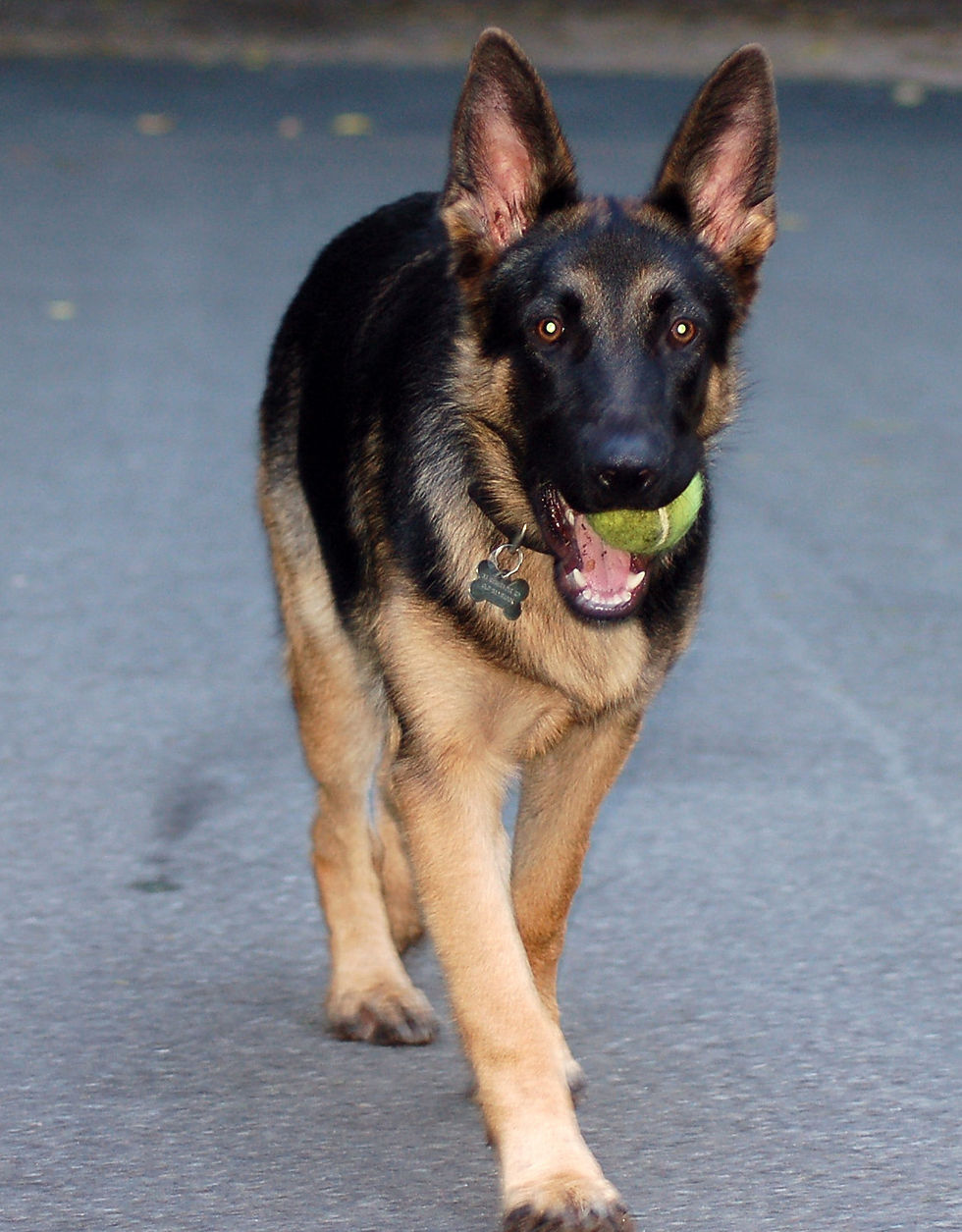Your Guide to Feeding & Exercising Large Breed Pups
- Belinda N. Ahern

- Sep 2
- 4 min read
We have quite a few new large breed puppies in our traini
ng programs & so I thought it a great time to talk about what we are feeding and the right time to add different types of exercise.

Let's begin with the recommendation to switch to adult food at six months.
We now know it can actually harm your growing puppy. Large and giant breeds have unique needs, and a one-size-fits-all approach doesn’t work.
Specially formulated large-breed growth diets are designed to slow rapid growth, prevent overfeeding, and support strong skeletal development. These diets are the safest and smartest way to give your puppy the foundation for lifelong health.
Common Questions from Puppy Parents
🥣 How much should I be feeding my puppy?
First we start by monitoring if our puppy is lean & not chubby by using the Body Condition Score (BCS) chart scored 1–9.
While every dog grows differently - even siblings- we may need to adjust portions to keep our pups around a 4/9 as we monitor their growth curve.
🦴 What if my puppy is showing s signs of orthopedic issues?
If you notice limping, stiffness, or uneven growth we need to immediately fine-tune their dietplan. Early support can make a huge difference in long-term outcomes.
⚖️ What if my puppy is getting pudgy?
We may need to slightly cut portions and increase safe, low-impact activities like leash walks or swimming. Avoid “crash diets” or adult weight-loss formulas. Puppies need balanced nutrition while they grow; the goal is controlled calories, not nutrient restriction. Prevention is far easier than correction.
🍲 Can I feed a homemade diet instead?
We do not recommend it as online recipes and “book diets” rarely balance calcium, phosphorus, and other key nutrients correctly. For large breeds, mistakes here can mean lifelong orthopedic damage. If you’re serious about homemade, get a professional recipe tailored to your puppy.
Exercise Guidelines for Large-Breed Puppies
Puppies may have endless energy—but that doesn’t mean their bones and joints are ready for endurance work.
Forced exercise = anything beyond what your pup would naturally choose during play with same-aged dogs (e.g., jogging, running alongside bikes, excessive fetch).
Growth plates in large breeds usually close between 12–15 months. Until then, avoid repetitive, high-impact exercise.
Safer options:
Swimming (joint-friendly and great conditioning).
Structured leash walks (short and steady).
Scent exploration and training games (mental exercise tires them out just as much as physical).
Think of your 6-month-old puppy like an 8–12-year-old child—full of energy but still developing. You wouldn’t send an 8-year-old to run a 5K every morning; the same principle applies to your dog.
The Takeaway
Stick with a large-breed growth formula.
Keep your puppy lean, not round—adjust food based on body condition, not the bag label.
Focus on smart exercise and mental enrichment until growth plates close.
Your large-breed puppy only gets one chance to grow. Making the right choices now means stronger joints, healthier bones, and a happier dog for years to come.
Nutrition & Exercise for the Large-Breed Dog
When it comes to raising a large-breed puppy, nutrition and exercise aren’t just daily choices—they’re lifelong investments in health and mobility. What you feed, how you exercise, and when you transition diets can set the stage for strong joints, a healthy weight, and a happier future together.
At BNADog, we cut through the noise of marketing claims to give you clear, evidence-based recommendations.
Making Informed Choices
Your veterinarian is your partner in long-term health, but as your trainer and wellness coach, my role is to help you understand why certain choices matter so much for large and giant breeds.
Nutrition: Building Strong Foundations
Growth vs. “All Life Stages”
Puppies need a diet labeled with a Nutritional Adequacy Statement that confirms it meets requirements for growth—or for all life stages.
If your dog is expected to weigh over 70 lbs as an adult, it’s critical to choose a large-breed growth formula.
Don’t be fooled by front-label marketing terms like “maintenance.” Always check the statement on the back of the bag.
When to Transition
Small and medium breeds reach ~80% of adult size by 12 months.
Large and giant breeds take longer—18–24 months—before they should fully transition to an adult formula.
Feeding a growth diet longer than needed isn’t harmful, but switching too early can be.
Regular vs. Large-Breed Puppy Foods
Large-breed growth diets are lower in calcium and less energy-dense, reducing risks of overfeeding and obesity.
Being overweight during growth is one of the biggest risk factors for developmental orthopedic disease (DOD).
Adult foods are not appropriate at 6 months for large breeds—they may contain the wrong calcium-phosphorus balance or too many calories, both of which stress growing bones.
Bottom Line on Feeding
Choose a reputable brand that has passed AAFCO feeding trials for growth.
Keep your puppy lean—BCS 4–5 on a 9-point scale—by adjusting calories, not just following the bag’s serving chart.
Remember: prevention of orthopedic issues starts in the food bowl.
Exercise: Protecting Joints While Building Strength
Large-breed puppies are bundles of energy, but their joints aren’t ready for endurance workouts.
Avoid forced exercise like jogging, biking, or excessive fetch until growth plates close (12–18 months).
Safe options include structured leash walks, swimming, and short training sessions that challenge body and mind.
Mental exercise—obedience, scent games, puzzle toys—is just as important as physical activity and helps burn energy safely.
The BNADog Approach
Feed for growth until your vet confirms it’s safe to transition.
Check your puppy’s Body Condition Score monthly.
Choose activity wisely—fun, joint-friendly, and developmentally appropriate.
Partner with us to create a plan tailored to your puppy’s breed, size, and lifestyle.
Your large-breed puppy only gets one shot at growing well. Smart choices now build the foundation for years of strength, mobility, and joy by your side.


Comments